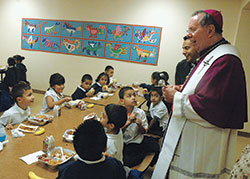Letters reveal the personal touch of Archbishop Buechlein

Archbishop Daniel M. Buechlein laughs while chatting with members of St. Philip Neri School’s kindergarten class on Oct. 20, 2009. He visited the school that day to bless it after major renovations had been completed. (File photo by Sean Gallagher)
By John Shaughnessy
Through their close friendship and their daily working arrangement, Msgr. Joseph F. Schaedel often saw the extra efforts that Archbishop Daniel M. Buechlein made to reach out to people.
“More than once, going or coming from somewhere, we would drive out of our way to pay a surprise visit to a generally elderly person who was a shut-in who had contacted him about something that most of us would find relatively insignificant,” recalled Msgr. Schaedel, the vicar general of the archdiocese during most of Archbishop Buechlein’s tenure.
Archbishop Buechlein was also known for taking time to visit people in hospitals and jails. He even administered the sacrament of confirmation to a few men on death row.
He also immersed himself in a Spanish language program, reflecting his desire to communicate better with the archdiocese’s rapidly growing Hispanic population.
Yet perhaps his most extended efforts to make connections with people involved the way he answered the mail he received.
“He would spend hours writing handwritten notes to people who had sent him a note asking for prayers, for advice,” said Msgr. Schaedel, now pastor of St. Luke the Evangelist Parish in Indianapolis.
That personal touch was a defining trait for the introverted spiritual leader. And that side of his personality often shined through in the correspondence he had with people—as revealed in some of the letters he wrote as archbishop, copies of which are stored in the archives of the archdiocese.
Consider this passage from the letter he wrote to Tony Dungy in 2002, shortly after Dungy was named as the new head coach of the Indianapolis Colts:
“I have been very impressed by the successes you have experienced in football and in civic life. Your commitment to being an exemplary coach, community leader and man of faith is certainly to be admired, and I am glad that you will be bringing your many gifts to our city. . .
“I would appreciate and enjoy the opportunity to meet you and welcome you to Indianapolis. As you settle in, it would be my pleasure to host you for lunch or a meeting.”
He also sent letters to grade-school children who had written him with questions about his life, including this one from a second-grade student named Makenzie:
“Dear Makenzie,
“Thank you for praying the Rosary and offering sacrifices for me and the other bishops! I really am happy that you chose me. My favorite story about Jesus is the story of the two disciples on the road to Emmaus Easter morning. . .
“I have met Peyton Manning, quarterback for the Indianapolis Colts, several times. My favorite color is blue, for the Colts.
“I enjoyed all of my years in school. When I was in second grade, I made my First Holy Communion. Thanks again for writing and your prayers. I offer a prayer for you.”
He also answered letters regarding the issues of our times, responding in 2005 to a woman’s thoughts on a concern that still divides our society—immigration.
“The Church responds to immigrants not from their legal status, but from the dictates of our belief and tradition. We in the U.S. are especially mindful of the immigrant because the Catholic Church in the U.S. is an immigrant Church, made up of people from all parts of the Earth. The Church has a responsibility to assist the newcomer.
“In Scripture, God calls upon his people to care for the alien. ... In chapter 25 of the Gospel of Matthew, Jesus identifies with the marginalized and commands us to respond when he said, ‘I was a stranger and you welcomed me.’ ”
His letters sometimes also offered a glimpse of his youth—a time when his father insisted that his teenaged son work during his summer breaks from Saint Meinrad Seminary so he would understand how people earned a living. So the future archbishop glazed doughnuts in a bakery and stacked lumber for a cabinet company.
In one of his letters, he shared his family memories of Christmas. In doing so, he also shared one of his defining approaches to life—living with hope.
“One memory I hold dear is going each December to Grandpa Buechlein’s farm with my dad and brother to find a cedar Christmas tree. Most of the time we did a good job of it, but not always. Yet, a less than perfectly shaped tree didn’t make a difference.
“Christmas always seemed to have its own magic. For a brief time, all was right with life, even when there were radio reports about Pope Pius XII’s Christmas pleas for peace during World War II. For a brief moment, even in that message, there was hope.
“There is more to the magic of Christmas than meets the eye. Unless one is hopelessly selfish, no matter how spiritually or materially poor we are, we can always try to follow Christ by finding something of ourselves to give to others, and in that giving we find hope.”
(Sean Gallagher contributed to this article.) †
